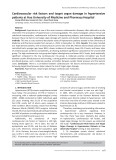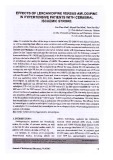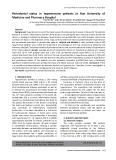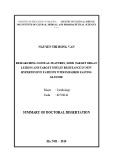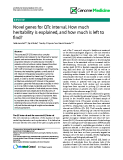
HUE JOURNAL OF MEDICINE AND PHARMACY ISSN 3030-4318; eISSN: 3030-4326 197
Hue Journal of Medicine and Pharmacy, Volume 14, No.6/2024
Prolonged QTc interval and its relationship to left ventricular
hypertrophy and left ventricular ejection fraction in hypertensive
patients
Le Thi Bich Thuan1*, Pham Hai Duong1, Nguyen Thi Hoai1, Nguyen Anh Huy1
(1) Hue University of Medicine and Pharmacy, Hue University
Abstract
Objective: The study aimed to determine the prevalence of prolonged QTc interval in hypertensive
patients and investigate its relationship and correlation with left ventricular hypertrophy and left ventricular
ejection fraction (EF) in hypertensive patients. Subjects and Methods: This study is a cross-sectional
descriptive study. The subjects were patients admitted to the Cardiology Department of Hue University
of Medicine and Pharmacy Hospital from February 2020 to February 2021, diagnosed with hypertension
according to the VNHA 2018 guidelines. The patients were divided into two groups: Group 1 with prolonged
QTc and Group 2 with normal QTc. Prolonged QTc was defined as QTc >450ms in males and >460ms in
females. All patients underwent echocardiography to assess left ventricular hypertrophy and left ventricular
ejection fraction (EF), and comparisons were made between the two groups. A p-value <0.05 was considered
statistically significant. Results: A total of 133 patients were included in the study, with males accounting for
50.4%. Among them, 41 cases (30.8%) had a prolonged QTc interval, while 92 cases (69.2%) had a normal
QTc interval. Patients in the prolonged QTc group had significantly lower ejection fraction and fractional
shortening (Fs), higher left ventricular mass index (LVMI), and greater end-diastolic volume (EDV) and end-
systolic volume (ESV) compared to those in the normal QTc group. QTc was negatively correlated with EF
and Fs and positively correlated with ESV and Ds. Furthermore, the prolonged QTc group had a higher
prevalence of heart failure, with statistically significant clinical symptoms of heart failure such as edema,
dyspnea, and tachycardia. Conclusion: The study indicates that prolonged QTc interval has a relatively high
prevalence among hypertensive patients. Prolonged QTc is associated with left ventricular hypertrophy and
left ventricular ejection fraction in hypertensive patients.
Keywords: QTc interval; hypertension; left ventricular hypertrophy; left ventricular ejection fraction.
Corresponding Author: Le Thi Bich Thuan. Email: ltbthuanvn@gmail.com
Received: 8/10/2024; Accepted: 24/11/2024; Published: 25/12/2024
DOI: 10.34071/jmp.2024.6.28
1. INTRODUCTION
Hypertension (HTN) is the most common
modifiable cardiovascular risk factor. The prevalence
of hypertension is increasing and is becoming younger
in age. Many studies have shown that a prolonged
corrected QT interval (QTc) on the electrocardiogram
(ECG) is associated with an increased risk of
cardiovascular mortality, all-cause mortality, and
the risk of ischemic heart disease in hypertensive
patients [1], [2], [3]. Research has demonstrated
that hypertension leads to left ventricular
hypertrophy (LVH), which alters conduction and
causes ventricular repolarization abnormalities,
resulting in prolonged QT intervals on resting ECG in
hypertensive heart disease [4]. Normally, the heart
functions as a coordinated muscle to contract and
relax, pumping blood to nourish the body, regulated
by the heart’s autonomic nodes to control heart rate
and rhythm. When the QTc interval is prolonged, it
extends the relative refractory period of the action
potential, disrupting the timing of each heartbeat
and triggering arrhythmias. This is the cause of
ventricular arrhythmias, sudden cardiac death,
stroke, and mortality in hypertensive patients [2],
[3].
With the aim of investigating the relationship
between prolonged QTc interval, left ventricular
hypertrophy, and left ventricular ejection fraction
(EF) in hypertensive patients, we conducted this
study with the objective to: identify prolonged QTc
in hypertensive patients and evaluate its correlation
with left ventricular hypertrophy and left ventricular
ejection fraction (EF) in this population.
2. STUDY SUBJECTS AND METHODS
Subjects and Methods
This study is a cross-sectional descriptive study.
The subjects were patients admitted to the Cardiology
Department of Hue University of Medicine and
Pharmacy Hospital from February 2020 to February






